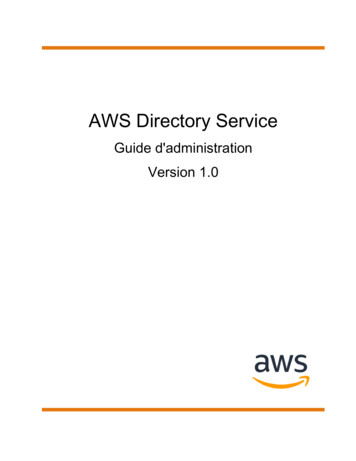
Transcription
Package ‘aws’January 11, 2021Version 2.5-1Date 2021-01-11Title Adaptive Weights SmoothingAuthor Joerg Polzehl [aut, cre],Felix Anker [ctb]Maintainer Joerg Polzehl joerg.polzehl@wias-berlin.de Depends R ( 3.4.0), awsMethods ( 1.1-1)Imports methods, gslDescription We provide a collection of R-functions implementingadaptive smoothing procedures in 1D, 2D and 3D. This includes thePropagation-Separation Approach to adaptive smoothing,the Intersecting Confidence Intervals (ICI), variational approaches and a non-local means filter.The package is described in detail in Polzehl J, Papafitsoros K, Tabelow K (2020).Patch-Wise Adaptive Weights Smoothing in R. Journal of Statistical Software, 95(6), 1-27. doi:10.18637/jss.v095.i06 ,Usage of the package in neuroimaging is illustrated in Polzehl and Tabelow (2019),Magnetic Resonance Brain Imaging, Appendix A, Springer, Use R! Series. doi:10.1007/978-3-030-29184-6 6 .License GPL ( 2)Copyright This package is Copyright (C) 2005-2020 WeierstrassInstitute for Applied Analysis and Stochastics.URL te 5.0.1NeedsCompilation yesRepository CRANDate/Publication 2021-01-11 22:40:12 UTCR topics documented:aws-package . . . . . . . . . . . . . . . . . . . . . . . . . . . . . . . . . . . . . . . . .auxiliary . . . . . . . . . . . . . . . . . . . . . . . . . . . . . . . . . . . . . . . . . . .125
2aws-packageaws . . . . . . . .aws-class . . . . .aws.gaussian . . .aws.irreg . . . . . .aws.segment . . . .awsdata . . . . . .awsLocalSigma . .awssegment-class .awstestprop . . . .awsweights . . . .binning . . . . . .extract-methods . .ICIcombined . . .ICIsmooth . . . . .ICIsmooth-class . .kernsm . . . . . . .kernsm-class . . .lpaws . . . . . . .nlmeans . . . . . .paws . . . . . . . .plot-methods . . .print-methods . . .qmeasures . . . . .risk-methods . . .show-methods . . .smooth3D . . . . .smse3ms . . . . . .summary-methods .TV denoising . . .vaws . . . . . . . .vpaws . . . . . . 7384142464647484950515354555862Adaptive Weights SmoothingDescriptionWe provide a collection of R-functions implementing adaptive smoothing procedures in 1D, 2D and3D. This includes the Propagation-Separation Approach to adaptive smoothing, the IntersectingConfidence Intervals (ICI), variational approaches and a non-local means filter. The package isdescribed in detail in Polzehl J, Papafitsoros K, Tabelow K (2020). Patch-Wise Adaptive WeightsSmoothing in R. Journal of Statistical Software, 95(6), 1-27. doi:10.18637/jss.v095.i06 , Usageof the package in neuroimaging is illustrated in Polzehl and Tabelow (2019), Magnetic ResonanceBrain Imaging, Appendix A, Springer, Use R! Series. doi:10.1007/978-3-030-29184-6 6 .
aws-package3DetailsThe DESCRIPTION right:URL:RoxygenNote:aws2.5-12021-01-11Adaptive Weights Smoothingc(person("Joerg","Polzehl",role c("aut","cre"),email keJoerg Polzehl [aut, cre], Felix Anker [ctb]Joerg Polzehl joerg.polzehl@wias-berlin.de R ( 3.4.0), awsMethods ( 1.1-1)methods, gslWe provide a collection of R-functions implementing adaptive smoothing procedures in 1D, 2D and 3D. ThisGPL ( 2)This package is Copyright (C) 2005-2020 Weierstrass Institute for Applied Analysis and hl/5.0.1Index of help topics:ICIcombinedICIsmoothICIsmooth-classTV kernsmkernsm-classAdaptive smoothing by Intersection ofConfidence Intervals (ICI) using multiplewindowsAdaptive smoothing by Intersection ofConfidence Intervals (ICI)Class '"ICIsmooth"'TV/TGV denoising of image dataAWS for local constant models on a gridClass '"aws"'Adaptive Weights SmoothingAdaptive weights smoothing for Gaussian datawith variance depending on the mean.local constant AWS for irregular (1D/2D) designSegmentation by adaptive weights for Gaussianmodels.3D variance estimationExtract information from an object of class awsClass '"awssegment"'Propagation condition for adaptive weightssmoothingGenerate weight scheme that would be used in anadditional aws stepBinning in 1D, 2D or 3DMethods for Function 'extract' in Package 'aws'Auxiliary functions (for internal use)Kernel smoothing on a 1D, 2D or 3D gridClass '"kernsm"'
ssummary-methodsvawsvpawsLocal polynomial smoothing by AWSNLMeans filter in 1D/2D/3DAdaptive weigths smoothing using patchesMethods for Function 'plot' from package'graphics' in Package 'aws'Methods for Function 'print' from package'base' in Package 'aws'Quality assessment for image reconstructions.Compute risks characterizing the quality ofsmoothing resultsMethods for Function 'show' in Package 'aws'Auxiliary 3D smoothing routinesAdaptive smoothing in orientation space SE(3)Methods for Function 'summary' from package'base' in Package 'aws'vector valued version of function 'aws' Thefunction implements the propagation separationapproach to nonparametric smoothing (formerlyintroduced as Adaptive weights smoothing) forvarying coefficient likelihood models withvector valued response on a 1D, 2D or 3D grid.vector valued version of function 'paws' withhomogeneous covariance structureAuthor(s)Joerg Polzehl [aut, cre], Felix Anker [ctb]Maintainer: Joerg Polzehl joerg.polzehl@wias-berlin.de ReferencesJ. Polzehl, K. Tabelow (2019). Magnetic Resonance Brain Imaging: Modeling and Data AnalysisUsing R. Springer, Use R! series. Appendix A. Doi:10.1007/978-3-030-29184-6.J. Polzehl, K. Papafitsoros, K. Tabelow (2020). Patch-Wise Adaptive Weights Smoothing in R, Journal of Statistical Software, 95(6), 1-27. doi:10.18637/jss.v095.i06 (URL: http://doi.org/10.18637/jss.v095.i06).J. Polzehl and V. Spokoiny (2006) Propagation-Separation Approach for Local Likelihood Estimation, Prob. Theory and Rel. Fields 135(3), 335-362. DOI:10.1007/s00440-005-0464-1.J. Polzehl, V. Spokoiny, Adaptive Weights Smoothing with applications to image restoration, J. R.Stat. Soc. Ser. B Stat. Methodol. 62 , (2000) , pp. 335–354. DOI:10.1111/1467-9868.00235.V. Katkovnik, K. Egiazarian and J. Astola (2006) Local Approximation Techniques in Signal andImage Processing, SPIE Press Monograph Vol. PM 157A. Buades, B. Coll and J. M. Morel (2006). A review of image denoising algorithms, with a newone. Simulation, 4, 490-530. DOI:10.1137/040616024.Rudin, L.I., Osher, S. and Fatemi, E. (1992). Nonlinear total variation based noise removal algorithms. Phys. D, 60, 259-268. DOI: 10.1016/0167-2789(92)90242-F.Bredies, K., Kunisch, K. and Pock, T. (2010). Total Generalized Variation. SIAM J. Imaging Sci.,3, 492-526. DOI:10.1137/090769521.
auxiliaryauxiliary5Auxiliary functions (for internal use)DescriptionFunction gethani determines a bandwidth that leads to, for the specified kernel, a variance reduction for a non-adaptive kernel estimate by a factor of value. getvofh calculates the sum oflocation weights for a given bandwidth vector and kernel. sofmchi precomputes the variance of anon-central chi distribution with 2*L degrees of freedom as a function of the noncentrality parameter for an interval c(0,to). Functions residualVariance and residualSpatialCorr are used inpackage fmri to calculate variances and spatial correlations from residual objects.Usagegethani(x, y, lkern, value, wght, eps 0.01)getvofh(bw, lkern, wght)sofmchi(L, to 50, delta 0.01)residualVariance(residuals, mask, resscale 1, compact FALSE)residualSpatialCorr(residuals, mask, lags c(5, 5, 3), compact FALSE)Argumentsxlower bound of search intervalyupper bound of search intervallkerncode for location kernelvaluetarget sum of location weightswghtrelative size of voxel dimensions c(0,0) for 1D and c(w1,0) for 2D problems.epsattempted precision for bandwidth searchbwvector of bandwidths, length equal to 1,2 or 3 depending on the dimensionalityof the problem.Lnumber of effective coils, 2*L is the degree of freedom of the non-central chidistribution.toupper interval bound.deltadiscretization width.residualsarray of residuals, ifcompact only containing voxel with mask, otherwise forcomplete data cubes.maskmask of active voxel (e.g. brain masks)resscalescale for residuals (residuals may be scaled for optimal integer*2 storage)compactlogical, determines if only information for voxel within mask or full for full datacubes is given.lagspositive integer vector of length 3, maximum lags for spatial correlations foreach coordinate direction to be computed
6awsDetailsThese are auxiliary functions not to be used by the user. They are only exported to be available forinternal use in packages fmri, dti, qMRI and adimpro.Valuegethani returns a vector of bandwidths, getvofh returns the variance reduction that would be obtained with a kernel estimate employing the specified kernel and bandwidth, sofmchi returns a listwith, e.g., components ncp and s2 containing vectors of noncentralityparameter values and corresponding variances, respectively, for the specified noncentral Chi distribution, residualVariancereturns a vector (compact TRUE) or array(compact FALSE) of voxelwise residual variances,residualSpatialCorr returns an array of dimension lags containing spatial correlations.NoteThese functions are for internal use only. They are only exported to be available in other packages.Author(s)Joerg Polzehl polzehl@wias-berlin.de awsAWS for local constant models on a gridDescriptionThe function implements the propagation separation approach to nonparametric smoothing (formerly introduced as Adaptive weights smoothing) for varying coefficient likelihood models on a1D, 2D or 3D grid. For "Gaussian" models, i.e. regression with additive "Gaussian" errors, ahomoskedastic or heteroskedastic model is used depending on the content of sigma2Usageaws(y,hmax NULL, mask NULL, aws TRUE, memory FALSE, family "Gaussian",lkern "Triangle", aggkern "Uniform",sigma2 NULL, shape NULL, scorr 0, spmin 0.25,ladjust 1,wghts NULL,u NULL,graph FALSE,demo FALSE,testprop FALSE,maxni FALSE)Argumentsyarray y containing the observe response (image intensity) data. dim(y) determines the dimensionality and extend of the grid design.hmaxhmax specifies the maximal bandwidth. Defaults to hmax 250,12,5 for 1D,2D, 3D images, respectively. In case of lkern "Gaussian" the bandwidth isassumed to be given in full width half maximum (FWHM) units, i.e., 0.42466times gridsize.
aws7awslogical: if TRUE structural adaptation (AWS) is used.maskoptional logical mask, same dimensionality as ymemorylogical: if TRUE stagewise aggregation is used as an additional adaptationscheme.familyfamily specifies the probability distribution. Default is family "Gaussian",also implemented are "Bernoulli", "Poisson", "Exponential", "Volatility", "Variance" and "NCchi". family "Volatility" specifies a Gaussian distributionwith expectation 0 and unknown variance. family "Volatility" specifies thatp*y/theta is distributed as χ2 with p shape degrees of freedom. family "NCchi"uses a noncentral Chi distribution with p shape degrees of freedom and noncentrality parameter thetalkerncharacter: location kernel, either "Triangle", "Plateau", "Quadratic", "Cubic"or "Gaussian". The default "Triangle" is equivalent to using an Epanechnikovkernel, "Quadratic" and "Cubic" refer to a Bi-weight and Tri-weight kernel, seeFan and Gijbels (1996). "Gaussian" is a truncated (compact support) Gaussiankernel. This is included for comparisons only and should be avoided due to itslarge computational costs.aggkerncharacter: kernel used in stagewise aggregation, either "Triangle" or "Uniform"sigma2sigma2 allows to specify the variance in case of family "Gaussian". Not usedif family! "Gaussian". Defaults to NULL. In this case a homoskedastic variance estimate is generated. If length(sigma2) length(y) then sigma2 isassumed to contain the pointwise variance of y and a heteroscedastic variancemodel is used.shapeAllows to specify an additional shape parameter for certain family models. Currently only used for family "Variance", that is χ-Square distributed observationswith shape degrees of freedom.scorrThe vector scorr allows to specify a first order correlations of the noise for eachcoordinate direction, defaults to 0 (no correlation).spminDetermines the form (size of the plateau) in the adaptation kernel. Not to bechanged by the user.ladjustfactor to increase the default value of lambdawghtswghts specifies the diagonal elements of a weight matrix to adjust for differentdistances between grid-points in different coordinate directions, i.e. allows todefine a more appropriate metric in the design space.ua "true" value of the regression function, may be provided to report risks at eachiteration. This can be used to test the propagation condition with u 0graphIf graph TRUE intermediate results are illustrated after each iteration step. Defaults to graph FALSE.demoIf demo TRUE the function pauses after each iteration. Defaults to demo FALSE.testpropIf set this provides diagnostics for testing the propagation condition. The valuesof y should correspond to the specified family and a global model.maxniIf TRUE use maxl k (Nipenalty.(l)(k)instead of (Niin the definition of the statistical
8awsDetailsThe function implements the propagation separation approach to nonparametric smoothing (formerly introduced as Adaptive weights smoothing) for varying coefficient likelihood models on a1D, 2D or 3D grid. For "Gaussian" models, i.e. regression with additive "Gaussian" errors, ahomoskedastic or heteroskedastic model is used depending on the content of sigma2. aws FALSEprovides the stagewise aggregation procedure from Belomestny and Spokoiny (2004). memory FALSEprovides Adaptive weights smoothing without control by stagewise aggregation.The essential parameter in the procedure is a critical value lambda. This parameter has an interpretation as a significance level of a test for equivalence of two local parameter estimates. Optimalvalues mainly depend on the choosen family. Values set internally are choosen to fulfil a propagation condition, i.e. in case of a constant (global) parameter value and large hmax the procedureprovides, with a high probability, the global (parametric) estimate. More formally we require the parameter lambda to be specified such that E θ̂k θ (1 α)E θ̃k θ where θ̂k is the aws-estimatein step k and θ̃k is corresponding nonadaptive estimate using the same bandwidth (lambda Inf).The value of lambda can be adjusted by specifying the factor ladjust. Values ladjust 1 lead toan less effective adaptation while ladjust 1 may lead to random segmentation of, with respect toa constant model, homogeneous regions.The numerical complexity of the procedure is mainly determined by hmax. The number of iterationsis approximately Const*d*log(hmax)/log(1.25) with d being the dimension of y and the constantdepending on the kernel lkern. Comlexity in each iteration step is Const*hakt*n with hakt beingthe actual bandwith in the iteration step and n the number of design points. hmax determines themaximal possible variance reduction.Valuereturns anobject of class aws with slotsy "numeric"ydy "numeric"dim(y)x "numeric"numeric(0)ni "integer" integer(0)mask "logical"logical(0)theta "numeric"Estimates of regression function, length: length(y)mae "numeric" Mean absolute error for each iteration step if u was specified, numeric(0) elsevar "numeric" approx. variance of the estimates of the regression function. Please note thatthis does not reflect variability due to randomness of weights.xmin "numeric"numeric(0)xmax "numeric"numeric(0)wghts "numeric"numeric(0), ratio of distances wghts[-1]/wghts[1]degree "integer"0
aws9hmax "numeric"effective hmaxsigma2 "numeric"provided or estimated error variancescorr "numeric"scorrfamily "character"familyshape "numeric"shapelkern "integer"integer code for lkern, 1 "Plateau", 2 "Triangle", 3 "Quadratic", 4 "Cubic",5 "Gaussian"lambda "numeric"effective value of lambdaladjust "numeric"effective value of ladjustaws "logical" awsmemory "logical"memoryhomogen "logical"homogenearlystop "logical"FALSEvarmodel "character""Constant"vcoef "numeric"numeric(0)call "function"the arguments of the call to awsNoteuse setCores 'number of threads' to enable parallel execution.Author(s)Joerg Polzehl, polzehl@wias-berlin.de , sJ. Polzehl, K. Tabelow (2019). Magnetic Resonance Brain Imaging: Modeling and Data AnalysisUsing R. Springer, Use R! series. Appendix A. Doi:10.1007/978-3-030-29184-6.J. Polzehl, K. Papafitsoros, K. Tabelow (2020). Patch-Wise Adaptive Weights Smoothing in R, Journal of Statistical Software, 95(6), 1-27. doi:10.18637/jss.v095.i06 (URL: http://doi.org/10.18637/jss.v095.i06).J. Polzehl, V. Spokoiny, Adaptive Weights Smoothing with applications to image restoration, J. R.Stat. Soc. Ser. B Stat. Methodol. 62 , (2000) , pp. 335–354. DOI:10.1111/1467-9868.00235.J. Polzehl, V. Spokoiny, Propagation-separation approach for local likelihood estimation, Probab.Theory Related Fields 135 (3), (2006) , pp. 335–362. DOI:10.1007/s00440-005-0464-1.
10aws-classSee AlsoSee also paws, lpaws, vaws,link{awsdata}, aws.irreg, aws.gaussianExamplesrequire(aws)# 1D local constant smoothing## Not run: demo(aws ex1)## Not run: demo(aws ex2)# 2D local constant smoothing## Not run: demo(aws ex3)aws-classClass "aws"DescriptionThe "aws" class is used for objects obtained by functions aws, lpaws, aws.irreg and aws.gaussian.Objects from the ClassObjects are created by calls to functions aws, lpaws, aws.irreg and aws.gaussian.Slots.Data: Object of class "list", usually empty.y: Object of class "array" containing the original (response) datady: Object of class "numeric" dimension attribute of ynvec: Object of class "integer" leading dimension of y in vector valued data.x: Object of class "numeric" if provided the design pointsni: Object of class "numeric" sum of weights used in final estimatemask: Object of class "logical" mask of design points where computations are performedtheta: Object of class "array" containes the smoothed object and in case of function lpaws itsderivatives up to the specified degree. Dimension is dim(theta) c(dy,p)hseq: Sequence of bandwidths employed.mae: Object of class "numeric" Mean absolute error with respect to array in argument u if provided.psnr: Object of class "numeric" Peak Signal to Noise Ratio (PSNR) with respect to array inargument u if provided.var: Object of class "numeric" pointwise variance of theta[.,1]xmin: Object of class "numeric" min of x in case of irregular designxmax: Object of class "numeric" max of x in case of irregular design
aws-class11wghts: Object of class "numeric" weights used in location penalty for different coordinate directions, corresponds to ratios of distances in coordinate directions 2 and 3 to and distance incoordinate direction 1.degree: Object of class "integer" degree of local polynomials used in function lpawshmax: Object of class "numeric" maximal bandwidthsigma2: Object of class "numeric" estimated error variancescorr: Object of class "numeric" estimated spatial correlationfamily: Object of class "character" distribution of y, can be any of c("Gaussian","Bernoulli","Poisson","Exponentshape: Object of class "numeric" possible shape parameter of distribution of ylkern: Object of class "integer" location kernel, can be any of fauts to "Triangle"lambda: Object of class "numeric" scale parameter used in adaptationladjust: Object of class "numeric" factor to adjust scale parameter with respect to its predetermined default.aws: Object of class "logical" Adaptation by Propagation-Separationmemory: Object of class "logical" Adaptation by Stagewise Aggregationhomogen: Object of class "logical" detect regions of homogeneity (used to speed up the calculations)earlystop: Object of class "logical" further speedup in function lpaws estimates are fixed ifsum of weigths does not increase with iterations.varmodel: Object of class "character" variance model used in function aws.gaussianvcoef: Object of class "numeric" estimates variance parameters in function aws.gaussiancall: Object of class "call" that created the object.Methodsextract signature(x "aws"): .risk signature(y "aws"): .plot Method for Function ‘plot’ in Package ‘aws’.show Method for Function ‘show’ in Package ‘aws’.print Method for Function ‘print’ in Package ‘aws’.summary Method for Function ‘summary’ in Package ‘aws’.Author(s)Joerg Polzehl, polzehl@wias-berlin.de ReferencesJoerg Polzehl, Vladimir Spokoiny, Adaptive Weights Smoothing with applications to image restoration, J. R. Stat. Soc. Ser. B Stat. Methodol. 62 , (2000) , pp. 335–354Joerg Polzehl, Vladimir Spokoiny, Propagation-separation approach for local likelihood estimation,Probab. Theory Related Fields 135 (3), (2006) , pp. 335–362.
12aws.gaussianSee Alsoaws, lpaws, aws.irreg, aptive weights smoothing for Gaussian data with variance depending on the mean.DescriptionThe function implements an semiparametric adaptive weights smoothing algorithm designed forregression with additive heteroskedastic Gaussian noise. The noise variance is assumed to dependon the value of the regression function. This dependence is modeled by a global parametric (polynomial) model.Usageaws.gaussian(y, hmax NULL, hpre NULL, aws TRUE, memory FALSE,varmodel "Constant", lkern "Triangle",aggkern "Uniform", scorr 0, mask NULL, ladjust 1,wghts NULL, u NULL, varprop 0.1, graph FALSE, demo FALSE)Argumentsyy contains the observed response data. dim(y) determines the dimensionalityand extend of the grid design.hmaxhmax specifies the maximal bandwidth. Defaults to hmax 250,12,5 for dd 1,2,3,respectively.hpreDescribe hpre Bandwidth used for an initial nonadaptive estimate. The firstestimate of variance parameters is obtained from residuals with respect to thisestimate.awslogical: if TRUE structural adaptation (AWS) is used.memorylogical: if TRUE stagewise aggregation is used as an additional adaptationscheme.varmodelImplemented are "Constant", "Linear" and "Quadratic" refering to a polynomialmodel of degree 0 to 2.lkerncharacter: location kernel, either "Triangle", "Plateau", "Quadratic", "Cubic"or "Gaussian". The default "Triangle" is equivalent to using an Epanechnikovkernel, "Quadratic" and "Cubic" refer to a Bi-weight and Tri-weight kernel, seeFan and Gijbels (1996). "Gaussian" is a truncated (compact support) Gaussiankernel. This is included for comparisons only and should be avoided due to itslarge computational costs.
aws.gaussian13aggkerncharacter: kernel used in stagewise aggregation, either "Triangle" or "Uniform"scorrThe vector scorr allows to specify a first order correlations of the noise for eachcoordinate direction, defaults to 0 (no correlation).maskRestrict smoothing to points where mask TRUE. Defaults to TRUE in all voxel.ladjustfactor to increase the default value of lambdawghtswghts specifies the diagonal elements of a weight matrix to adjust for differentdistances between grid-points in different coordinate directions, i.e. allows todefine a more appropriate metric in the design space.ua "true" value of the regression function, may be provided to report risks at eachiteration. This can be used to test the propagation condition with u 0varpropSmall variance estimates are replaced by varprop times the mean variance.graphIf graph TRUE intermediate results are illustrated after each iteration step. Defaults to graph FALSE.demoIf demo TRUE the function pauses after each iteration. Defaults to demo FALSE.DetailsThe function implements the propagation separation approach to nonparametric smoothing (formerly introduced as Adaptive weights smoothing) for varying coefficient likelihood models on a1D, 2D or 3D grid. In contrast to function aws observations are assumed to follow a Gaussiandistribution with variance depending on the mean according to a specified global variance model.aws FALSE provides the stagewise aggregation procedure from Belomestny and Spokoiny (2004).memory FALSE provides Adaptive weights smoothing without control by stagewise aggregation.The essential parameter in the procedure is a critical value lambda. This parameter has an interpretation as a significance level of a test for equivalence of two local parameter estimates. Values setinternally are choosen to fulfil a propagation condition, i.e. in case of a constant (global) parameter value and large hmax the procedure provides, with a high probability, the global (parametric)estimate. More formally we require the parameter lambda to be specified such that E θ̂k θ (1 α)E θ̃k θ where θ̂k is the aws-estimate in step k and θ̃k is corresponding nonadaptive estimate using the same bandwidth (lambda Inf). The value of lambda can be adjusted by specifyingthe factor ladjust. Values ladjust 1 lead to an less effective adaptation while ladjust 1 maylead to random segmentation of, with respect to a constant model, homogeneous regions.The numerical complexity of the procedure is mainly determined by hmax. The number of iterationsis approximately Const*d*log(hmax)/log(1.25) with d being the dimension of y and the constantdepending on the kernel lkern. Comlexity in each iteration step is Const*hakt*n with hakt beingthe actual bandwith in the iteration step and n the number of design points. hmax determines themaximal possible variance reduction.Valuereturns anobject of class aws with slotsy "numeric"ydy "numeric"dim(y)x "numeric"numeric(0)
14aws.gaussianni "integer" integer(0)mask "logical"logical(0)theta "numeric"Estimates of regression function, length: length(y)mae "numeric" Mean absolute error for each iteration step if u was specified, numeric(0) elsevar "numeric" approx. variance of the estimates of the regression function. Please note thatthis does not reflect variability due to randomness of weights.xmin "numeric"numeric(0)xmax "numeric"numeric(0)wghts "numeric"numeric(0), ratio of distances wghts[-1]/wghts[1]degree "integer"0hmax "numeric"effective hmaxsigma2 "numeric"provided or estimated error variancescorr "numeric"scorrfamily "character""Gaussian"shape "numeric"NULLlkern "integer"integer code for lkern, 1 "Plateau", 2 "Triangle", 3 "Quadratic", 4 "Cubic",5 "Gaussian"lambda "numeric"effective value of lambdaladjust "numeric"effective value of ladjustaws "logical" awsmemory "logical"memoryhomogen "logical"homogenearlystop "logical"FALSEvarmodel "character"varmodelvcoef "numeric"estimated parameters of the variance modelcall "function"the arguments of the call to aws.gaussian
aws.irreg15Author(s)Joerg Polzehl, polzehl@wias-berlin.de , sJoerg Polzehl, Vladimir Spokoiny, Adaptive Weights Smoothing with applications to image restoration, J. R. Stat. Soc. Ser. B Stat. Methodol. 62 , (2000) , pp. 335–354Joerg Polzehl, Vladimir Spokoiny, Propagation-separation approach for local likelihood estimation,Probab. Theory Related Fields 135 (3), (2006) , pp. 335–362.Joerg Polzehl, Vladimir Spokoiny, in V. Chen, C.; Haerdle, W. and Unwin, A. (ed.) Handbookof Data Visualization Structural adaptive smoothing by propagation-separation methods SpringerVerlag, 2008, 471-492See AlsoSee also aws, link{awsdata}, aws.irregExamplesrequire(aws)aws.irreglocal constant AWS for irregular (1D/2D) designDescriptionThe function implements the propagation separation approach to nonparametric smoothing (formerly introduced as Adaptive weights smoothing) for varying coefficient Gaussian models on a 1Dor 2D irregulat design. The function allows for a paramertic (polynomial) mean-variance dependence.Usageaws.irreg(y, x, hmax NULL, aws TRUE, memory FALSE, varmodel "Constant",lkern "Triangle", aggkern "Uniform", sigma2 NULL, nbins 100,hpre NULL, henv NULL, ladjust 1, varprop 0.1, graph FALSE)ArgumentsyThe observed response vector (length n)xDesign matrix, dimension n x d, d %in% 1:2hmaxhmax specifies the maximal bandwidth. Unit is binwidth in the first dimension.awslogical: if TRUE structural adaptation (AWS) is used.memorylogical: if TRUE stagewise aggregation is used as an additional adaptationscheme.
16aws.irregvarmodeldetermines the model that relates variance to mean. Either "Constant", "Linear"or "Quadratic".lkerncharacter: location kernel, either "T
4 aws-package lpaws Local polynomial smoothing by AWS nlmeans NLMeans filter in 1D/2D/3D paws Adaptive weigths smoothing using patches plot-methods Methods for Function 'plot' from package 'graphics' in Package 'aws' print-methods Methods for Function 'print' from package 'base' in Package 'aws'










